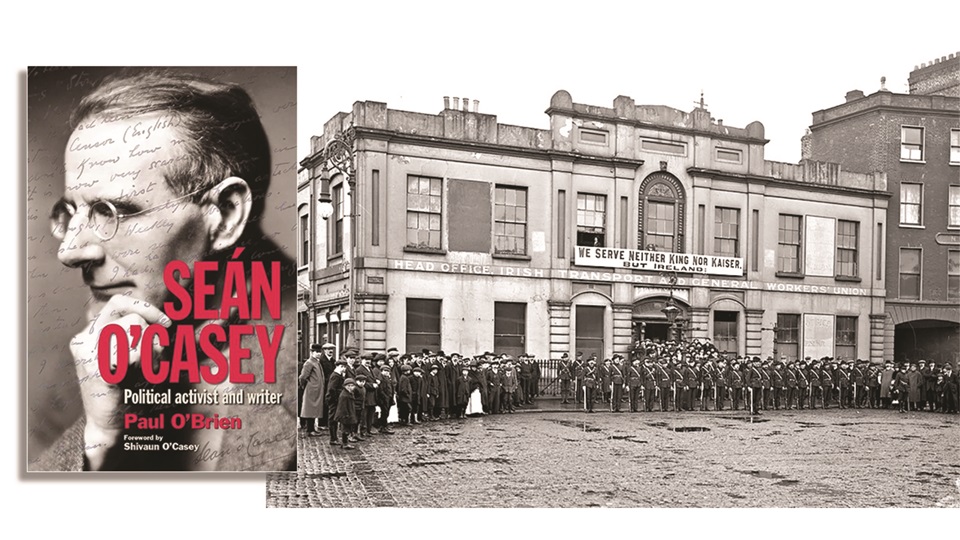
Anybody who has come across the work of independent scholar and critic Paul O’Brien knows that his interest lies in the radical tradition of literature and history. He came to my attention with his book Shelly and Revolutionary Ireland (2002). Now, O’Brien has published an impressive volume on Seán O’Casey.
He is perhaps the first Irish author to look comprehensively at the dramatist in political and historical terms, firmly setting the plays into this context from a left-wing perspective. An extensive bibliography reveals the formidable amount of specialist reading that informs this study.
It is accessibly written and sheds light on details of working-class Dublin and international history. An interest in one of Ireland’s great playwrights, a keenness in discovering more about his plays and times is all that is needed to enjoy the book. While the study is an important one for O’Casey scholars to be aware of, it is refreshingly equally directed at readers beyond academia.
O’Brien’s book is not a biography, nor is the book, as its author puts it: “an exclusive critical or literary analysis of his work, but an exploration of the interplay between the political and historical context of O’Casey’s life and its representation in his drama and prose and the way O’Casey negotiated the interplay between politics and aesthetics.”
O’Brien’s interest in Irish labor history is evident in his informative account of late 19th and early 20th century Dublin working-class life and events, following O’Casey’s development and the context from which arose his plays. Into this fall the writer’s involvement with the Irish language and nationalist movement.
O’Casey joined the Irish Republican Brotherhood in 1905 and was later instrumental in the establishment of the Irish Citizen Army, which he left before the 1916 Rising. As O’Brien points out, O’Casey’s defining experience had been the Great Lockout of 1913, and much space is rightly devoted to his trade union activism and to Jim Larkin, the towering organizer of the 1913 Great Lockout.
Less space is spared for the fellow leader of the Lockout, the Marxist James Connolly, with whom O’Casey broke. O’Brien sheds some light on this disagreement, focusing on O’Casey’s position, who prioritized the class struggle above the struggle for national liberation, which required an alliance with the class enemy.
Here, it could have been useful to outline Connolly’s stance of an anti-imperialist alliance in a little more detail for balance. Where O’Casey shows part of the truth as he sees it, the reader would benefit from understanding the full picture from a left-wing point of view.
This breach was significant in terms of the position O’Casey took in relation to the Easter Rising and subsequently, informing his three early Dublin plays, which each examine momentous events concerned with the struggle for Irish independence.
It might have been helpful for readers not especially conversant with the specific details of the Rising, if O’Brien had made clearer that O’Casey did not accurately reflect the degree of working-class involvement in 1916.
Also check out:
Sean O’Casey’s three revolutionary plays staged in New York and Ann Arbor
A significant proportion of the forces of both the Irish Citizens Army (ICA) and the Volunteers were working-class people, who identified with and fought for the vision of the Easter Proclamation of a democratic Republic: “We declare the right of the people of Ireland to the ownership of Ireland and to the unfettered control of Irish destinies, to be sovereign and indefeasible.”
O’Brien’s extensive reading and knowledge of drama and the arts is reflected throughout the book and kindles reader interest in the development of working-class drama. This information is very welcome and enriching in a book about O’Casey, an aspect that is rarely included in O’Casey criticism, and essential to illuminating the context from which grew the first working-class dramatist of international standing, writing in English.
The chapter entitled “The New Drama” provides much detail and a sense of the times which produced this drama as well as the importance attached to cultural expression and playwriting by the revolutionary working class.
The author’s refreshingly wide awareness of European Theatre is evident in his presentation of O’Casey in the context of the left-wing European playwrights of the 1920s and ’30s—Brecht, and Toller, but also Denis Johnston in Britain and the wave of expressionism that characterized the era.
O’Brien is similarly well versed in the history of the Abbey and O’Casey’s struggle for his plays to be performed there, his relationship with Yeats, Augusta Gregory, as well as his final resignation and departure for England when The Silver Tassie was rejected.
While O’Brien devotes most space to discussions of the Dublin tragedies, he is cognizant of O’Casey’s later plays and brings them into the study, setting each in its time, introducing and discussing them in terms of the writer’s outlook.
O’Casey’s canon beyond the Dublin trilogy is little known in Ireland and the anglophone world; his fantastic mature plays have rarely if ever been performed here. This is in contrast to the socialist countries, where O’Casey was a standard part of the repertoire and known mainly for his later work.
In the German Democratic Republic (East Germany), O’Casey was one of the most frequently staged Western dramatists. O’Brien creates an interest in these later plays and presents their artistic as well as political merit.
Seán O’Casey, writing at almost 80, affirmed “I am still a Republican, a Communist, and, in a way, a member of the Gaelic League.” O’Brien relates that O’Casey had been approached by the Irish Workers’ League to support the future general secretary of the Communist Party of Ireland, Michael O’Riordan, in the May 1951 elections.
Although O’Casey replied saying his endorsement would damage O’Riordan’s chances, and that he would instead donate towards the fund, his affirmation of O’Riordan in the same letter was used in the election leaflet. Robert Lowery states: “His ardent enthusiasm and life-long adulation for the USSR, which he considered one of the world’s greatest human experiments in creating a society of a new type, deserves primacy in evaluating his socialist legacy.”
O’Brien states his purpose is to concentrate “on a political reading of O’Casey on his terms”, and he does this for large sections of the book. He departs from this approach when discussing the dramatist’s position as a lifelong supporter of the communist movement and the Soviet Union, where his own position takes precedence over O’Casey’s. When this context arises, O’Casey is associated exclusively with the term Stalinism and any differences with the Communist Party of Great Britain are highlighted and praised.
Seán O’Casey: Political Activist and Writer is an interesting, informative, and enjoyable read and a valuable addition to the canon of O’Casey commentary. It is far more than a book of academic criticism, although it is that, too.
Seán O’Casey: Political Activist and Writer
By Paul O’Brien
Cork University Press, 2023
388 pages, €39.00
We hope you appreciated this article. At People’s World, we believe news and information should be free and accessible to all, but we need your help. Our journalism is free of corporate influence and paywalls because we are totally reader-supported. Only you, our readers and supporters, make this possible. If you enjoy reading People’s World and the stories we bring you, please support our work by donating or becoming a monthly sustainer today. Thank you!










